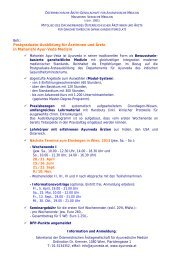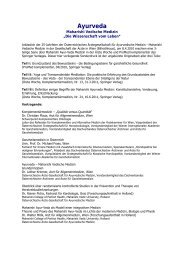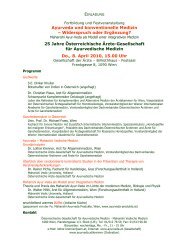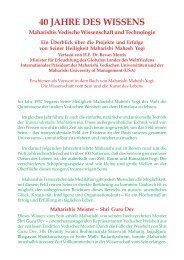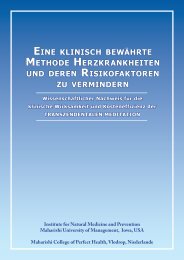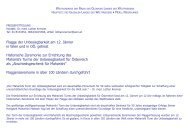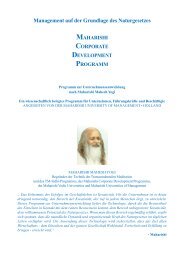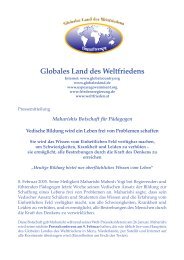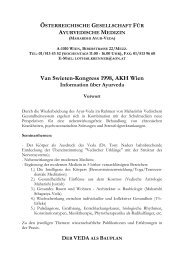Summary of Research Findings
Summary of Research Findings
Summary of Research Findings
Create successful ePaper yourself
Turn your PDF publications into a flip-book with our unique Google optimized e-Paper software.
<strong>Research</strong> on Anti-Aging, Neurophysiology and Intelligence (continued)<br />
4. Title<br />
Antioxidant Properties <strong>of</strong> Two Ayurvedic Herbal Preparations [MAK-4 and MAK-5]<br />
Publication<br />
Biochemical Archives, Vol. 10, pp. 25-31, 1994.<br />
Authors<br />
Stephen C. Bondy, Tina M. Hernandez, and Cara Mattia.<br />
Conducted at<br />
Department <strong>of</strong> Community and Environmental Medicine, University <strong>of</strong> California (Irvine), Irvine, CA 92717<br />
<strong>Summary</strong><br />
This study investigated the antioxidant effects <strong>of</strong> MAK-4 and MAK-5 in the rat brain in vitro and in vivo. In<br />
vitro, ethanol and aqueous extracts <strong>of</strong> MAK-4 and MAK-5 were able to quench generation <strong>of</strong> reactive oxygen<br />
species within an isolated fraction <strong>of</strong> rat cerebral cortex enriched in mitochondria and nerve endings (synaptosomes).<br />
In vivo, the excess production <strong>of</strong> reactive oxygen species observed within the cerebellar mitochondrial<br />
fraction after exposure <strong>of</strong> rats to toluene, was prevented by pretreatment with MAK-5.<br />
For more information on this study, see <strong>Research</strong> on Reduction <strong>of</strong> Chemical Toxicity and Antioxidant<br />
<strong>Research</strong>.<br />
Study 4 <strong>Research</strong> Highlights<br />
In vivo and in vitro studies showed that MAK-4 and MAK-5 were able to quench the excess generation <strong>of</strong> reactive<br />
oxygen species in rat brains.<br />
5. Title<br />
Effect <strong>of</strong> Maharishi Amrit Kalash [MAK-5] on Brain Opioid Receptors and Neuropeptides<br />
Publication<br />
The Journal <strong>of</strong> <strong>Research</strong> and Education in Indian Medicine, Vol. 10, No. 1, pp. 1-8, 1991.<br />
Authors<br />
Hari M. Sharma,* Silva Hanissian,** Anil K. Rattan,** Stephen L.<br />
Stern,† and Gopi A. Tejwani.**<br />
Conducted at<br />
*Department <strong>of</strong> Pathology, **Department <strong>of</strong> Pharmacology, and<br />
†Division <strong>of</strong> Psychiatry, College <strong>of</strong> Medicine, The Ohio State<br />
University, Columbus, OH 43210<br />
<strong>Summary</strong><br />
MAK-5 was tested for its effects on opioid receptors in the<br />
brain, and on neuropeptides. In vitro tests using animal brain tissue<br />
showed that MAK-5 inhibited the binding <strong>of</strong> mu, kappa, and delta<br />
opioid receptors. Opioid peptides binding to these receptors are<br />
known to trigger changes in analgesia, behavior, appetite, endocrine<br />
and autonomic functions, and modulation <strong>of</strong> the immune system.<br />
Levels <strong>of</strong> Substance P, a neurotransmitter involved in pain pathways<br />
68



